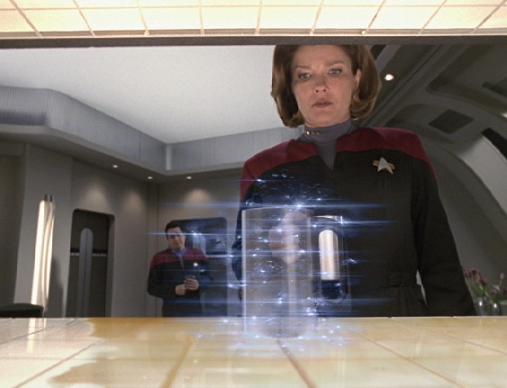They seem to have self-replicating mines, for god-sakes... how about replicating phaser arrays, plating, life-support systems, etc.
-
5The premise is that only items made of mundane materials can be created. A warp core contains exotic sorts of matter and/or matter shaped at the nanoscale which cannot be replicated. However, nothing prevents them from using it to repair other parts of the ship (hallways, bulkheads, carpeting, even air that was unintentionally decompressed). It's doubtful that they carry a bunch of spare parts around, after all. Of course, being Star Trek, when it's inconvenient to bad writing, all bets are off.– John OCommented Mar 26, 2013 at 20:53
-
1While I don't feel like tracking it down right now, there was an early episode of Voyager that discussed their limited supplies, and what could and could not be replicated (such as the gel packs).– IzkataCommented Mar 26, 2013 at 23:08
-
4For pretty much the same reason that the computer--which can simultaneously emulate several persons' intellect and personality for mere entertainment purposes--is not used to solve problems: it is bad for story telling to have a genie that will grant arbitrary wishes (unless improperly phrased wishes are dangerous). Artificial limits--limitations? On wishes?--prevent solving every problem by "use the genie" or viewers asking "why didn't they use the genie?". IMO, it was a mistake to link replicator and transporter technology--too much opportunity for inconsistency.– user11683Commented Mar 26, 2013 at 23:49
-
1Source on self-replicating mines? Also, see this answer (which is about closely-related transporter technology) that discusses the difficulties of transporting weapons: scifi.stackexchange.com/questions/28490/…– CamelBluesCommented Mar 27, 2013 at 13:58
-
1Also, don't forget the power requirements for replication. Chances are that many of the parts of the warp core and other systems are replicated, but as complexity and mass increase chances are power requirements would as well, possibly to the tune of ^3 or more.– Tyson of the NorthwestCommented Mar 27, 2013 at 17:46
4 Answers
The question assumes facts not in evidence; we don't know that replicator technology isn't used to effect repairs, we just haven't seen it.
But there is a philosophical answer to your question: Repairs require judgment and coordination. We've seen automated systems reroute power and communications, and if a big hole gets shot into the side of the ship, the computer erects a force-field. But if you "repair" a power system that someone else is working on, you might electrocute them. If the captain wants to play dead and lure the enemy in, he can't have the ship growing new parts and turning the lights back on to spoil the illusion. The computers on Enterprise are very capable indeed and probably could conduct deep space missions without a crew, but Starfleet philosophy seems to be to severely limit machine autonomy. Starfleet officers seem to have a deep distrust of computer judgment beyond a second or two in the future and prefer to keep people in the decision loop as much as possible. Having Borg-like self-healing ships would be a step too far for the civilization the Federation has chosen to have.
-
This makes sense; the Star Trek future seems to be about preserving individual autonomy and initiative as much as possible. Any arguments about efficiency would miss the point. There's really no reason for the Enterprise to have a crew of hundreds except for this kind of reasoning. Commented Mar 28, 2013 at 5:49
-
This is a good answer, and would be improved by some references (to Star Fleet philosophy, or captains' behavior). I also seem to remember there being references to "industrial" and "class 5" (or some such) replicators that were much larger, or much more sophisticated, or otherwise used for construction, but not suited to use on a starship. IIRC, in DS9, some civilization asked for high-capacity replicators to help with a natural disaster, or to rebuild after a war, and the Federation was reluctant to provide them because they could also be used to make weapons.– MattCommented Jan 29, 2014 at 16:22
It is being done. In one episode of Star Trek: Enterprise, there is a fully automated repair station that can replicate ship's parts and then teleport them in place. It probably cannot repair warp core though.

-
Yes another awesome innovation which was conveniently forgotten in the ST universe. Commented Dec 16, 2014 at 3:52
-
2That was alien technology so it's not relevant to "replicator technology" really.– JasmineCommented May 27, 2015 at 20:55
It is simply a matter of size. The on-board replicators do not have the capacity to produce a warp core. For that purpose, one needs an industrial replicator, which is referred to several times.
Replicators may be able to create simple components (such as bulkheads and the like), but it has been consistently demonstrated that that they have limits and that there are many substances that they cannot create. For example, Latinum is so treasured by the Ferengi because it cannot be replicated. Considering how insanely complex warp cores and similar technologies are, it seems reasonable that at least one of the following cannot be replicated:
deuterium
anti-deuterium
dilithium
cryonetrium
saurium-krellide
verterium cortenide
platinum-cobalt alloy
nanopolymer
...the list goes on.
Also we have to take into consideration the fact that replicators cannot create substances that are poisonous or incredibly dangerous-- this definitely rules out antimatter. The most important reason would probably be that ultimately replicators are too accident-prone to entrust to such sensitive equipment, at least the pieces of it that they can create.
Good thing that was coffee and not plasma coolant!
